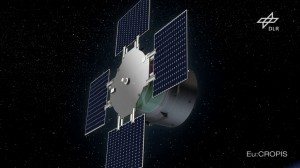The German Aerospace Center (DLR) is readying two greenhouses for launch in 2016, both contained within a 250-kilogram lightweight satellite. Once in Earth orbit, the spacecraft is designed to rotate around its longitudinal axis
In doing so, it will replicate lunar gravity, that is 0.16 times Earth’s, or 0.38 times – the gravity on Mars – depending on the rotational speed.
The experiment involves use of bacteria and algae that will convert synthetic urine into fertilizer to promote the growth of tomato plants. Variations in rotational speed around its longitudinal axis will simulate lunar and Martian gravity.
Year-long experiment
The first of the two greenhouses will operate under lunar conditions over the first six months, while the second greenhouse will operate in a Martian environment for the following six.
This project will run for a year, after which the satellite will reenter the Earth’s atmosphere.
Eu:CROPIS carries two other experiments: the DLR Institute of Aerospace Medicine will use the radiation detector RAMIS (Radiation Measurement in Space) to collect data on long-term exposure to cosmic radiation over the course of the space flight.
The radiation field in space presents a limiting factor for the long-term deployment of astronauts and every other biological system – whether it is plants, animals, or microorganisms.
NASA is contributing an experiment to measure photosynthesis in algae.
Survival in hostile environments
Numerous cameras and sensors onboard Eu:CROPIS will observe what is occurring inside the greenhouses during the mission.
For example, are the tomatoes growing properly, and is their photosynthesis satisfactory? What is the pH value and oxygen concentration in the water circulating continuously to transport nutrients throughout the entire greenhouse?
“We intend to demonstrate that waste products can be used in reduced gravity environments found on Mars and the Moon, also in long duration missions, in this case to cultivate tomatoes,” explains the mission’s scientific director, Jens Hauslage from the DLR Institute of Aerospace Medicine.
“The experiments on board Eu:CROPIS will deliver important results to enable humankind to survive in hostile environments…whether it be in space or here on Earth,” Hauslage adds.
By Leonard David

